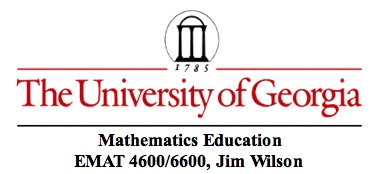

Mathematics problem solving is our topic. There is a danger that we have become so glib about "problem solving" that we no longer find sufficient substance in the term. I often use terms like "investigation," "exploration," "open-ended," "problem contexts," or "constructing mathematics" to warn students that the answer getting exercises they have been led to believe are problem solving are only a small part of the process. Perhaps the following quote from Polya captures some of the spirit of problem solving in mathematics.Your problem may be modest; but if it challenges your curiosity and brings into play your inventive faculties, and if you solve it by your own means, you may experience the tension and enjoy the triumph of discovery. Such experiences at a susceptible age may create a taste for mental work and leave their imprint on mind and character for a lifetime. (Polya, How to Solve It, 1945, p. v.)
We will spend our time in this course solving problems and posing more problems than we solve.
It is useful to have a framework to think about the processes involved in mathematical problem solving. Most formulations of a problem solving framework in U. S. textbooks attribute some relationship to Polya's problem solving stages (1945). These stages were described by 1) understanding the problem, 2) making a plan, 3) carrying out the plan, and 4) looking back.
Polya also stated that problem solving was a major theme of doing mathematics and when he wrote about what he expected of students, he used the language of "teaching students to think" (1965). "How to think" is a theme that underlies much of genuine inquiry and problem solving in mathematics. Unfortunately, much of the well-intended efforts of teaching students "how to think" in mathematics problem solving gets transformed into teaching "what to think" or "what to do." This is, in particular, a byproduct of an emphasis on procedural knowledge about problem solving such as we have in the linear framework of U. S. mathematics textbooks and the very limited problems/exercises included in lessons. To quote Polya again:Thus a teacher of mathematics has a great opportunity. If he fills his allotted time with drilling his students in routine operations he kills their interest, hampers their intellectual development, and misuses his opportunity. But if he challenges the curiosity of his students by setting them problems proportionate to their knowledge, and helps them to solve their problems with stimulating questions, he may give them a taste for, and some means of, independent thinking.(Polya, 1945, p. v.)
There is a dynamic and cyclic nature of genuine problem solving. A student may begin with a problem and engage in thought and activity to understand it. The student attempts to make a plan and in the process may discover a need to understand the problem better. Or when a plan has been formed, the student may attempt to carry it out and be unable to do so. The next activity may be attempting to make a new plan, or going back to develop a new understanding of the problem, or posing a new (possibly related) problem to work on.
The framework at the right is useful for illustrating the dynamic, cyclic interpretation of Polya's stages. Any of the arrows could describe student activity (thought) in the process of solving mathematics problems. Clearly, genuine problem experience in mathematics can not be captured by the outer, one-directional arrows alone. It is not a theoretical model. Rather, it is a framework for discussing various pedagogical, curricular, instructional, and learning issues involved with the goals of mathematical problem solving in our schools.
One aspect of "Looking Back" is the generation of new problems. New problems and investigations may spring from any of the following:
1. New problems suggested by the one we have worked on.
2. Generalizations of the results of a problem.
3. Generalizations of the strategies and techniques.
4. Searches for "better" solutions.
5. Searches for alternative solutions.
6. Explorations to understand the problem, its results, or its strategies.
7. Serendipity
8. Curiosity
9. Imagination
10. Stubbornness
There will be many examples in the material from this course.
References
- Polya, G. (1945) How to Solve It: A New Aspect of Mathematical Method. Princeton, NJ: Princeton University Press.
- Polya, G. (1965) Mathematical Discovery. New York: Wiley.
- Courant, R., & Robbins, H. (1941) What is Mathematics? An Elementary Approach to Ideas and Methods. New York: Oxford University Press. (Revised Edition prepared by Ian Stewart, 1996)